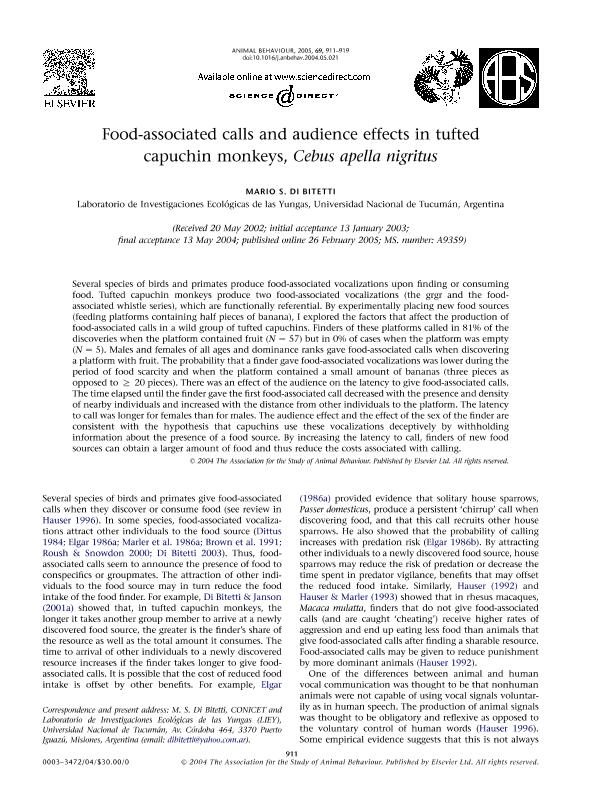Mostrar el registro sencillo del ítem
dc.contributor.author
Di Bitetti, Mario Santiago

dc.date.available
2018-05-17T17:46:49Z
dc.date.issued
2005-04
dc.identifier.citation
Di Bitetti, Mario Santiago; Food-associated calls and audience effects in tufted capuchin monkeys, Cebus apella nigritus; Academic Press Ltd - Elsevier Science Ltd; Animal Behaviour; 69; 4; 4-2005; 911-919
dc.identifier.issn
0003-3472
dc.identifier.uri
http://hdl.handle.net/11336/45480
dc.description.abstract
Several species of birds and primates produce food-associated vocalizations upon finding or consuming food. Tufted capuchin monkeys produce two food-associated vocalizations (the grgr and the food-associated whistle series), which are functionally referential. By experimentally placing new food sources (feeding platforms containing half pieces of banana), I explored the factors that affect the production of food-associated calls in a wild group of tufted capuchins. Finders of these platforms called in 81% of the discoveries when the platform contained fruit (N = 57) but in 0% of cases when the platform was empty (N = 5). Males and females of all ages and dominance ranks gave food-associated calls when discovering a platform with fruit. The probability that a finder gave food-associated vocalizations was lower during the period of food scarcity and when the platform contained a small amount of bananas (three pieces as opposed to ≥ 20 pieces). There was an effect of the audience on the latency to give food-associated calls. The time elapsed until the finder gave the first food-associated call decreased with the presence and density of nearby individuals and increased with the distance from other individuals to the platform. The latency to call was longer for females than for males. The audience effect and the effect of the sex of the finder are consistent with the hypothesis that capuchins use these vocalizations deceptively by withholding information about the presence of a food source. By increasing the latency to call, finders of new food sources can obtain a larger amount of food and thus reduce the costs associated with calling.
dc.format
application/pdf
dc.language.iso
eng
dc.publisher
Academic Press Ltd - Elsevier Science Ltd

dc.rights
info:eu-repo/semantics/openAccess
dc.rights.uri
https://creativecommons.org/licenses/by-nc-nd/2.5/ar/
dc.subject
Audience Effect
dc.subject
Capuchin Monkeys
dc.subject
Cebus Apella Nigritus
dc.subject
Food Associated Calls
dc.subject.classification
Zoología, Ornitología, Entomología, Etología

dc.subject.classification
Ciencias Biológicas

dc.subject.classification
CIENCIAS NATURALES Y EXACTAS

dc.title
Food-associated calls and audience effects in tufted capuchin monkeys, Cebus apella nigritus
dc.type
info:eu-repo/semantics/article
dc.type
info:ar-repo/semantics/artículo
dc.type
info:eu-repo/semantics/publishedVersion
dc.date.updated
2018-05-09T14:17:32Z
dc.journal.volume
69
dc.journal.number
4
dc.journal.pagination
911-919
dc.journal.pais
Estados Unidos

dc.description.fil
Fil: Di Bitetti, Mario Santiago. Universidad Nacional de Tucumán. Facultad de Ciencias Naturales e Instituto Miguel Lillo. Laboratorio de Investigaciones Ecológicas de las Yungas; Argentina. Consejo Nacional de Investigaciones Científicas y Técnicas; Argentina
dc.journal.title
Animal Behaviour

dc.relation.alternativeid
info:eu-repo/semantics/altIdentifier/doi/http://dx.doi.org/10.1016/j.anbehav.2004.05.021
dc.relation.alternativeid
info:eu-repo/semantics/altIdentifier/url/https://www.sciencedirect.com/science/article/pii/S0003347204004749
Archivos asociados
